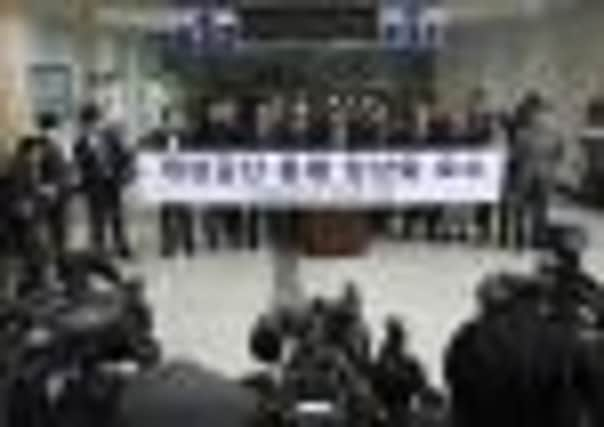UK ‘could be in North Korean range’, warns Cameron


• North Korea warns that it has cleared its military to attack US with “smaller, lighter and diversified nuclear weapons”.
• Declaration is the latest escalation in North Korean rhetoric as Pyongyang addresses US “aggression”.
Advertisement
Hide AdAdvertisement
Hide Ad• Analysts predict North Korea will stop short of waging nuclear war.
He spoke out after North Korea moved its long-range missiles to its east coast, putting them closer to the US.
A combination of the North’s nuclear capability and its unpredictable leadership under Kim Jong-un has left Mr Cameron “very concerned” about the unfolding situation on the Korean peninsula. “The fact is, as I read in a newspaper article this morning, North Korea does now have missile technology that is able to reach and able to hit the whole of the United States,” he said.
“If they’re able to reach the whole of the United States, they can reach Europe too. They can reach us too. That is a real concern.”
The warning came as South Korea’s defence minister said Pyongyang had moved missiles with “considerable range” towards its eastern coastline. But Kim Kwan-jin said they did not have the range to strike the US mainland.
US Congressman: ‘America has right to strike first’ He did not know the reasons behind the redeployment of the weapon, saying it “could be for testing or drills”. He dismissed reports in the Japanese media that the missile could be a KN-08, which is believed to be a long-range missile that, if operable, could hit the US. His description suggests it could be a mobile missile called the Musudan, believed to have a range of 1,800 miles. That would make Japan and South Korea – both of which have US bases – potential targets, but there are doubts about its accuracy.American troops in South Korea were placed on high alert after the North’s military said it has been authorised to attack the US using “smaller, lighter, and diversified” nuclear weapons. While few analysts believe North Korea has mastered the technology required to miniaturise nuclear bombs and mount them on long-range missiles, its latest war cry is not being treated as mere rhetoric.The US is also taking decisive action. A missile shield known as a Terminal High Altitude Area Defence System will be located on the US Pacific territory of Guam within weeks, while warships have been sent to the area. James Hardy, Asia Pacific editor of IHS Jane’s Defence Weekly, said: “From what we know of its existing inventory, North Korea has short- and medium-range missiles that could complicate a situation on the Korean peninsula and perhaps reach Japan, but we have not seen any evidence that it has long-range missiles that could strike the continental US, Guam or Hawaii.”Dr Chris Ogden: World should be worried by Korean sabre-rattling
Mr Kim said if North Korea was preparing for a full-scale conflict, there would be signs such as the mobilisation of a number of units, including supply and rear troops, but South Korean military officials have found no such preparations.
“[North Korea’s recent threats] are rhetorical threats. I believe the odds of a full-scale provocation are small,” he said. But he added the North might mount a small-scale attack such as its 2010 shelling of a South Korean island, which killed four people.
Advertisement
Hide AdAdvertisement
Hide AdJapanese premier Shinzo Abe said that, while North Korea’s rhetoric was “increasingly provocative”, Tokyo would “calmly” watch the situation. However, his government’s spokesman earlier said Japan was braced for a “worst-case scenario”.
Russia’s foreign ministry said Pyongyang’s attempts to “violate decisions of the UN Security Council were categorically unacceptable”, adding: “This radically complicates, if it doesn’t in practice shut off, the prospects for resuming six-party talks.”
Pyongyang has been railing against joint US and South Korean military exercises in the South and has expressed anger over tightened UN sanctions following its February nuclear test. Analysts say the threats are probably efforts to provoke softer policies from South Korea, to win diplomatic talks with Washington and to solidify the image of young North Korean leader Kim Jong-un.
At times, Pyongyang has gone beyond rhetoric. On Tuesday, it announced it would restart a plutonium reactor it had shut down in 2007. A US research institute said satellite imagery showed construction needed for the restart had already begun.
For a second day yesterday, the North’s border authorities denied entry to South Koreans who jointly run factories in the North Korean city of Kaesong. South Koreans already at the plant were being allowed to return home.
North Korea’s statement yesterday said its troops had been authorised to counter US “aggression” with “powerful practical military counteractions,” including nuclear weapons. It said America’s “hostile policy” and “nuclear threat” against the North “will be smashed by the strong will of all the united service personnel and people and cutting-edge smaller, lighter and diversified nuclear strike means”.
US defence secretary Chuck Hagel said Washington was doing all it could to defuse the situation.
NORTH KOREA’S ARSENAL
Hwasong-5: range of 300km. Can deliver conventional warheads but could also have biological, chemical and nuclear capabilities
Advertisement
Hide AdAdvertisement
Hide AdHwasong-6: range is 500km. Warhead and diverse capabilities very similar to the Hwasong-5
Musudan: an intermediate-range ballistic missile. Varying estimates of its capabilities, ranging from 3,200km to 4,000km
Nodong: a medium range missile with a range of 1,000km
Taepodong-1: a long-range missile combining the technologies in the Hwasong-5, Hwasong-6 and Nodong
Taepodong-2: a two to three-stage ballistic missile, and a significant advance on the Taepodong-1. Its range has been estimated at anything between 5,000 and 15,000km